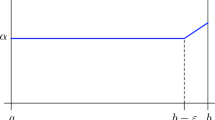Summary
Maximum and minimum principles for certain plate bending problems are derived in a unified manner from the canonical theory of complementary variational principles for multiple operator equations. The minimum principle is known in the literature, but the maximum principle appears to be new. A new error bound for approximate variational solutions is also presented.
Similar content being viewed by others
References
S. G. Mikhlin,Variational methods in mathematical physics, Pergamon Press, Oxford (1964).
A. M. Arthurs,Complementary variational principles, Clarendon Press, Oxford (1970).
A. M. Arthurs,J. Math. Anal. Appl., 41 (1973) 781–795.
A. M. Arthurs and C. W. Coles,Proc. Camb. Phil. Soc., 72 (1972) 229–232.
S. H. Gould,Variational methods for eigenvalue problems, University of Toronto Press (1966).
Author information
Authors and Affiliations
Rights and permissions
About this article
Cite this article
Arthurs, A.M., Reeves, R.I. Complementary variational principles for a class of biharmonic problems. J Eng Math 8, 167–173 (1974). https://doi.org/10.1007/BF02353619
Received:
Issue Date:
DOI: https://doi.org/10.1007/BF02353619



